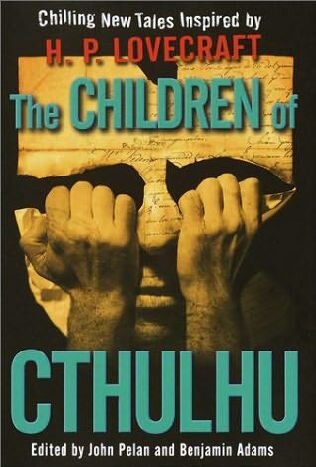Children of Cthulhu: a d∞ Book Review

 The literary world of the Cthulhu Mythos continues to grow with The Children of Cthulhu, a 2002 short story compilation edited by John Pelan and Benjamin Adams with cover illustration by Dave McKean and published by Ballantine Books. The anthology features a number of well regarded contemporary authors of horror fiction, including Alan Dean Foster and Poppy z, Brite. But are their contributions worthy additions to the body of mythos fiction or unnecessary expansions on the already voluminous glut of mythos lore?
The literary world of the Cthulhu Mythos continues to grow with The Children of Cthulhu, a 2002 short story compilation edited by John Pelan and Benjamin Adams with cover illustration by Dave McKean and published by Ballantine Books. The anthology features a number of well regarded contemporary authors of horror fiction, including Alan Dean Foster and Poppy z, Brite. But are their contributions worthy additions to the body of mythos fiction or unnecessary expansions on the already voluminous glut of mythos lore?
On the whole, The Children of Cthulhu is a well done compilation. With a small handful of exceptions, the stories within are set in the contemporary world and work the surreal cosmic horror of H.P. Lovecraft into times and settings more familiar to the modern reader. While most of these stories are of good quality, a few stand out, either due to exceptional caliber or exceptional limitation.
"Meet Me on The Other Side", by Yvonne Navarro is the story of two extreme sports and spelunking enthusiasts and their hunt for the lost city of Bethmoora, a mystic local created by Lord Dunsany in his short story of the same name and mentioned by Lovecraft in "The Whisperer in Darkness". The presence of these two unconventional protagonists hooks the reader from the start, but quickly disappoints. What progress they make in their investigation comes from a series of increasingly magical coincidences and not from their own ambitions or abilities. The fit and physically active protagonists also lend themselves to a more high action story, but they spend most of their time hiking. "Meet Me on The Other Side" holds two unique distinctions within mythos fiction. First, it is likely the only mythos story wherein the central tome, The Encyclopedia Cthulhiana, is a book published by Chaosium, publishers of the Call of Cthulhu roleplaying game. Second, the main characters’ response to their ultimate and inevitable fate when confronted by the mind-shattering terror of the mythos boils down to “oh, that sounds like it’ll be an adventure.” As a result, Yvonne Navarro’s contribution to the anthology is rendered anticlimactic and somewhat dull.
The two contributions that truly stand out are "The Invisible Empire" by James Van Pelt and "Long Meg and Her Daughters" by Paul Finch. "The Invisible Empire" is of particular interest to players and Keepers of the Call of Cthulhu RPG as it could serve as the starting point of an excellent campaign. The story, written in the first person perspective of a mulatto geologist working in the Colorado Territory several years after the Civil War, has the feel of a protracted player’s handout such as an uncovered journal or autobiography that prompts the investigators to explore the old mine shafts of that region. Regardless of its applications for mythos gaming, James Van Pelt’s contribution is a work of atmospheric storytelling that pays loving tribute to the prose of Lovecraft without aping the old master’s style.
"Long Meg and Her Daughters" does the unthinkable, merging cosmic horror with car chases, police shootouts, and high explosives. However, it does this successfully, creating a detective story that flows into a horror story that flows into action/adventure and then back into horror for a literally explosive climax. Finch demonstrates that academics are not the only protagonists fit to grace the pages of mythos fiction, and he does so without falling into the superheroics typified by the mythos adventures of Brian Lumley.
There are a number of other contributions that are worthy of note. Brian Hodge’s "Firebrand Symphony" and "Red Clay" by Michael Reaves are both atmospheric portrayals of the mythos and its influence on artists and the art they create. Mark Chadbourn’s "Sour Places" executes a cunning reversal, spinning a horror yarn with a terror all too human while using the mythos as a backdrop.
Despite a pair of lackluster contributions, The Children of Cthulhu is an anthology worth reading. On the whole the stories within are excellent contributions to the Cthulhu Mythos and can serve as inspiration for hours worth gaming within Lovecraft's literary universe.